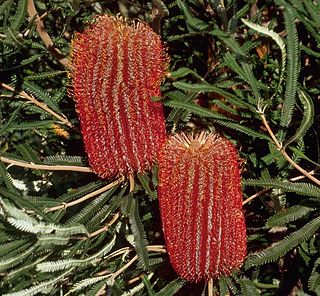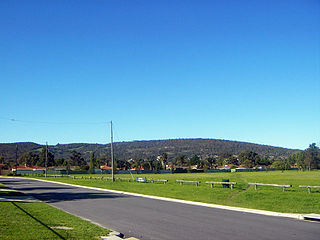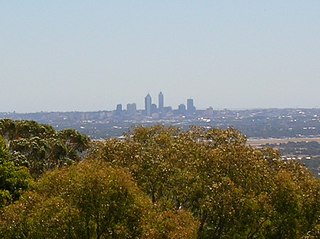
Banksia ilicifolia, commonly known as holly-leaved banksia, is a tree in the family Proteaceae. Endemic to southwest Western Australia, it belongs to Banksia subg. Isostylis, a subgenus of three closely related Banksia species with inflorescences that are dome-shaped heads rather than characteristic Banksia flower spikes. It is generally a tree up to 10 metres (33 ft) tall with a columnar or irregular habit. Both the scientific and common names arise from the similarity of its foliage to that of the English holly Ilex aquifolium; the glossy green leaves generally have very prickly serrated margins, although some plants lack toothed leaves. The inflorescences are initially yellow but become red-tinged with maturity; this acts as a signal to alert birds that the flowers have opened and nectar is available.

Banksia grandis, commonly known as Bull Banksia, Giant Banksia or Mangite, is a common and distinctive banksia tree in South West Western Australia. The Noongar peoples know the tree as Biara, Boongura or Peera.

Banksia brownii, commonly known as feather-leaved banksia or Brown's banksia, is a species of shrub that grows in southwest Western Australia. An attractive plant with fine feathery leaves and large red-brown flower spikes, it usually grows as an upright bush around two metres (7 ft) high, but can also occur as a small tree or a low spreading shrub. First collected in 1829 and published the following year, it is placed in Banksia subgenus Banksia, section Oncostylis, series Spicigerae. There are two genetically distinct forms.

Banksia attenuata, commonly known as the candlestick banksia, slender banksia or biara as known by the Noongar aboriginal people, is a species of plant in the family Proteaceae. Commonly a tree, it reaches 10 m (33 ft) high, but is often a shrub in drier areas 0.4 to 2 m high. It has long narrow serrated leaves and bright yellow inflorescences, or flower spikes, held above the foliage, which appear in spring and summer. The flower spikes age to grey and swell with the development of the woody follicles. It is found across much of the southwest of Western Australia, from north of Kalbarri National Park down to Cape Leeuwin and across to Fitzgerald River National Park.

Banksia prionotes, commonly known as acorn banksia or orange banksia, is a species of shrub or tree of the genus Banksia in the family Proteaceae. It is native to the southwest of Western Australia and can reach up to 10 m (33 ft) in height. It can be much smaller in more exposed areas or in the north of its range. This species has serrated, dull green leaves and large, bright flower spikes, initially white before opening to a bright orange. Its common name arises from the partly opened inflorescence, which is shaped like an acorn. The tree is a popular garden plant and also of importance to the cut flower industry.

Banksia menziesii, commonly known as firewood banksia, is a species of flowering plant in the genus Banksia. It is a gnarled tree up to 10 m (33 ft) tall, or a lower spreading 1–3 m (3.3–9.8 ft) shrub in the more northern parts of its range. The serrated leaves are dull green with new growth a paler grey green. The prominent autumn and winter inflorescences are often two-coloured red or pink and yellow, and their colour has given rise to more unusual common names such as port wine banksia and strawberry banksia. Yellow blooms are rarely seen.

Banksia sceptrum, commonly known as the sceptre banksia, is a plant that grows in Western Australia near the central west coast from Geraldton north through Kalbarri to Hamelin Pool. It extends inland almost to Mullewa. First collected and grown by early settler James Drummond in Western Australia, it was described by Swiss botanist Carl Meissner in 1855.

The Baxter's banksia, also known as bird's nest banksia, is a species of shrub in the plant genus Banksia. It occurs along the south coast of Western Australia between Albany and Esperance.

Banksia burdettii, commonly known as Burdett's banksia, is a species of shrub or tree of the genus Banksia in the family Proteaceae. It occurs on sandplain country north of Gingin, Western Australia. Growing to 4 m (13 ft) in height, it has long serrated leaves and large, bright flower spikes, initially white before opening to a bright orange, that appear mainly in late summer. Edmund Gilbert Baker described B. burdettii in 1934, naming it after its collector, W. Burdett. Once established the plant is resistant to both frost and drought, it prefers sun or light shade and well drained soils.

The Propeller Banksia is a species of shrub in the plant genus Banksia. It occurs in sandplain country north of Gingin, Western Australia.

Banksia elegans, commonly known as the elegant banksia, is a species of woody shrub in the genus Banksia of the family Proteaceae. Reaching 4 m (13 ft) high, it is a suckering shrub which rarely reproduces by seed. The round to oval yellow flower spikes appear in spring and summer. Swiss botanist Carl Meissner described Banksia elegans in 1856. It is most closely related to the three species in the subgenus Isostylis. It occurs only over a 65 square kilometre area north and west of Eneabba, Western Australia.

Banksia speciosa, commonly known as the showy banksia, is a species of large shrub or small tree in the family Proteaceae. It occurs on the south coast of Western Australia between Hopetoun (33°57′ S) and the Great Australian Bight, growing on white or grey sand in shrubland. Reaching up to 8 m (26 ft) in height, it is a single-stemmed plant that has thin leaves with prominent triangular "teeth" along each margin, which are 20–45 cm (7.9–17.7 in) long and 2–4 cm (0.8–1.6 in) wide. The prominent cream-yellow flower spikes known as inflorescences appear throughout the year. As they age they develop up to 20 follicles each that store seeds until opened by fire. Banksia speciosa. Though widely occurring, it is highly sensitive to dieback and large populations of plants have succumbed to the disease.

Banksia telmatiaea, commonly known as swamp fox banksia or rarely marsh banksia, is a shrub that grows in marshes and swamps along the lower west coast of Australia. It grows as an upright bush up to 2 metres tall, with narrow leaves and a pale brown flower spike, which can produce profuse quantities of nectar. First collected in the 1840s, it was not published as a separate species until 1981; as with several other similar species it was previously included in B. sphaerocarpa.

Banksia tricuspis, commonly known as Lesueur banksia or pine banksia, is a plant in the family Proteaceae and is endemic to a small area in the south-west of Western Australia. It is a stunted tree or shrub with narrow leaves and cylindrical spikes of golden-coloured flowers and it occurs in a geographic range of just 15 square kilometres near Jurien.

Banksia victoriae, commonly known as Woolly Orange Banksia, is a species of large shrub or small tree in the plant genus Banksia. It occurs in Western Australia between Northampton, Western Australia and Kalbarri, with the occasional plant further north as far as Zuytdorp Nature Reserve.

Banksia nivea, commonly known as Honeypot Dryandra, is a shrub endemic to Western Australia. The Noongar peoples know the plant as Bulgalla.
First described as Banksia nivea, it was transferred to Dryandra as Dryandra nivea by Robert Brown in 1810, and remained in that genus until 2007, when all Dryandra species were transferred to Banksia by Austin Mast and Kevin Thiele.
Eneabba sandplain or the Eneabba portion of the Northern sandplain, is an extension of the Swan Coastal Plain in Western Australia.




















